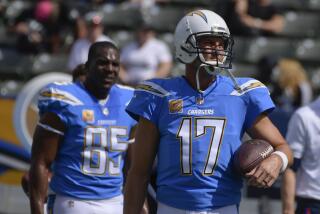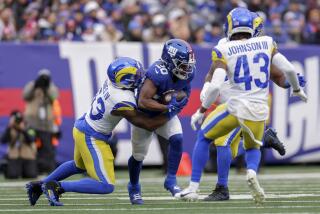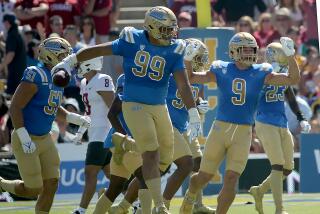SUPER BOWL XXV : BUFFALO BILLS vs. NEW YORK GIANTS : Parcells Takes It Slowly : Giants: Coach has succeeded with a conservative tempo, based on ball control and rugged defense.
TAMPA, Fla. — Nearly a minute of the third quarter remained in San Francisco Sunday, and the New York Giants were still trailing, 13-9, when Coach Bill Parcells directed his offensive team to stand around as the 45-second clock ticked to the end.
In such an interval, the Buffalo Bills, with quarterback Jim Kelly in fast forward, could have scored a couple of touchdowns.
But the Giants this season are the best, and toughest, member of the NFL’s conservative wing. They are a slow-tempo team--the stark opposite of the go-go Bills. They were sure that, eventually, they would eliminate the 49ers--and eventually they did, 15-13--and here they are in Tampa.
In the bright, smog-free sunshine of a cool Florida Monday, after mixing briefly with the others arriving early for next Sunday’s 25th Super Bowl game, the Giants got together to consider what they will have to do to outscore a Buffalo team that overwhelmed the Raiders, 51-3.
“We’ve held our own in shoot-outs before,” Parcells said, referring, apparently, to a 34-24 loss to San Francisco a year ago.
But this isn’t the same Buffalo team that lost an exhibition against the Giants last summer before winning Dec. 15 in Giants Stadium, 17-13.
“The Bills have really accelerated the pace in the last few weeks,” said Harry Hulmes, the Giants’ assistant general manager, who noted that Kelly has converted the AFC-champion Bills into the fastest-striking offensive team the Giants have ever faced.
“The Giants or anyone else,” he said.
That’s the matchup: the pass-oriented, new-look, rapid-firing Bills vs. a typical old-line, power-oriented NFC champion--a Giant team that prefers to rest its case on defense.
Most of those who saw the Bills rout the Raiders expect a Buffalo reprise in the Super Bowl. The Giants, however, are a different kind of ballclub--with better linebackers and more certain ball-control players.
Here’s a brief look at the team that scored the only upset of the playoffs this winter, surprising the 49ers Sunday after drubbing the NFC’s other division champion, Chicago, a week earlier:
GIANT PASS OFFENSE
As Parcells suggested, the Giants can compete in a shoot-out with Kelly--if it can’t be avoided--because they have Jeff Hostetler at quarterback now.
A Giant backup for seven years, Hostetler, 6 feet 3 and 215 pounds, is much more mobile than his predecessor, injured Phil Simms. And he is getting to be a more dependable clutch passer--in the third-down crises that kept happening in San Francisco Sunday, for example, when Parcells’ running backs were stopped on early downs.
“You can’t win consistently these days without a move man like Hostetler,” said Hank Stram, the CBS announcer who coached Kansas City to victory in Super Bowl IV. “The thing that makes this guy is accuracy and anticipation (on pass plays) and above all his quick feet.”
One of the two or three best running quarterbacks in the NFL, Hostetler, an A-minus scholar in his West Virginia days, is relatively inexperienced--with only six NFL starts, in which he is 6-0--but has made up for it in the playoffs this month by adding a cerebral dimension.
Said Giant center Bart Oates, a lawyer in his other life: “You can’t be an effective NFL quarterback unless you have a presence, and Jeff’s a smart one. He has it.”
The irony is that the Giants only allow Hostetler to throw the ball freely in selected situations--when they’re playing catch-up, or when the other side lacks the firepower to retaliate with passes.
The notion that Hostetler could come out throwing and quickly put a good opponent away--as Kelly did in the Raider game--is one that Parcells rejects out of hand.
Thus the efficient Giant receivers--Mark Ingram, Stephen Baker and particularly tight end Mark Bavaro--have spent much of their lives as blockers and decoys. It has been a waste. But the Giants will waste them again in the Buffalo game unless their fear of Kelly leads to a shoot-out.
GIANT RUNNING GAME
This is one of the league’s dullest running teams, now that it has lost Rodney Hampton to injury. At 33, O.J. Anderson is the Giants’ plugger. His alternate, Dave Meggett, 5-7 and 180, is too small to be the kind of hammer Parcells wants. The coach opposed the drafting of Meggett. And Maurice Carthon is a journeyman fullback.
Yet the Giants run. Well.
One reason is that Oates makes the blocking calls that always seem to open adequate holes for Anderson and Meggett.
Often more pivotal is the blocking of the giant Giant at left tackle, 305-pound John Elliott, known as Jumbo.
“He dominates people,” said Oates, “I haven’t seen anyone stay with Jumbo.”
When Elliott was hurt earlier this season, the Giants averaged 111.8 yards rushing. Since his return, the average has risen to 149.9. Against San Francisco’s stout defense, New York backs carried the ball 36 times for 152 net yards.
The Giants also lead the league in fourth-down ground yardage. Parcells equates fourth-down running with wide-open football.
On earlier downs, he is perhaps less daring than any other pro coach.
“I prefer to say that Parcells is patient,” said Giant scout Tim Rooney, adding that the coach’s conservatism will slow the Bills. “It’s not something we’ll have to invent. Patient is the way we are.”
GIANT DEFENSE
When the 1986 Giants won Super Bowl XXI, pushing the Denver Broncos around in Pasadena, 39-20, they were essentially a defensive team, although Simms completed most of his passes and set a championship game record.
Four years later they still are a defensive team, the NFL’s best--having held 18 opponents this season to an average of 12.6 points.
On the average, in other words, the Giants win any time they can get a touchdown, any old way, and two field goals.
In today’s high-powered football, that’s extraordinary.
Accordingly, looking ahead to the Super Bowl, Rooney said: “Our (game plan) is to control the game with our defense. It’s what we do best.”
The Bills, however, will be striking fast, combining three or four receivers in no-huddle formations with a shotgun quarterback, Kelly, and one of the NFL’s most dangerous draw-play runners, Thurman Thomas.
“There are only two things to do, and the Raiders did both,” said Rooney, who scouted the Raider-Bill game. “You can use extra defensive backs as linebackers, or you can use linebackers to cover their receivers.
“When the Raiders put in more defensive backs, the Bills ran Thomas. When they left their linebackers on the field, Kelly threw the ball. It’s a tough problem.”
Briefly, the Raiders also tried one other mechanism, a three-man line. Noting it instantly, Kelly responded by taking the Bills out of fast forward and beating the 3-4 with T-formation power plays.
The Giants are a 3-4 defensive team normally--with two particular strongpoints in the defensive line, right end Leonard Marshall and nose tackle Erik Howard. Howard made the hit that caused the fumble that led to the field goal that beat the 49ers on the last play.
One Giant question is whether linebacker Lawrence Taylor will be a decisive factor against the fast-go Bills. Even against the 49ers, Taylor was merely standing around instead of attacking Roger Craig when the big fumble came to him in Candlestick Park.
The Giants’ keys against Kelly Sunday are more likely to be Marshall, linebacker Carl Banks and cornerback Mark Collins, the big men in the machine that has made New York the NFL’s defensive power. The Bills can’t win without outplaying those three.
Next: A look at the Buffalo Bills.
More to Read
Go beyond the scoreboard
Get the latest on L.A.'s teams in the daily Sports Report newsletter.
You may occasionally receive promotional content from the Los Angeles Times.










